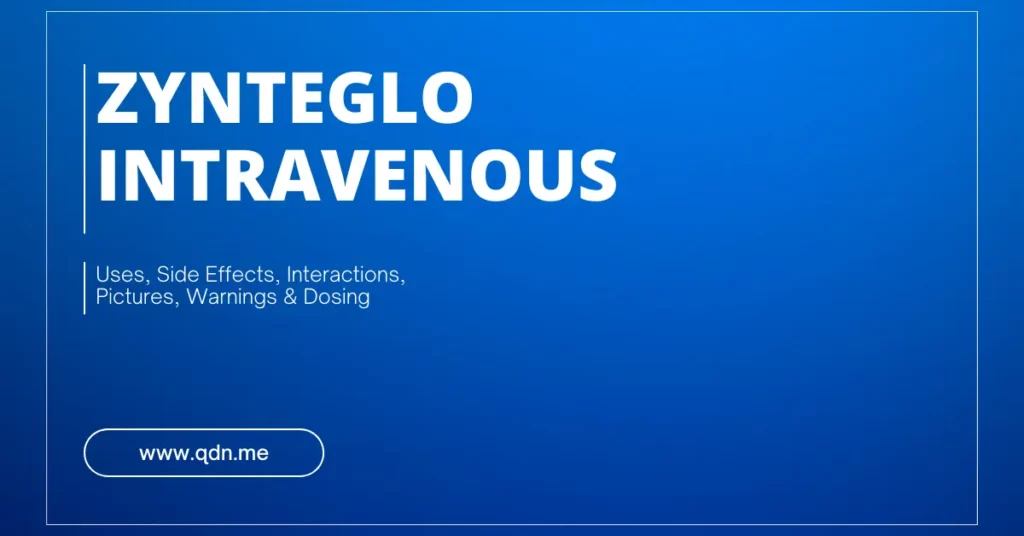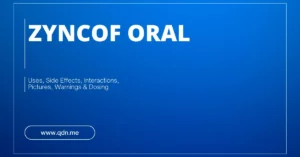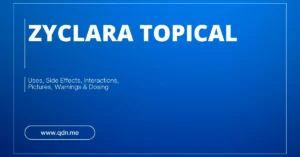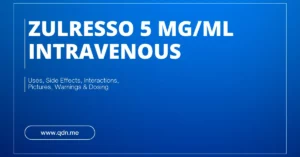Zynteglo Intravenous: Uses, Side Effects, Interactions, Pictures, Warnings & Dosing
Zynteglo Intravenous is a gene therapy that has been making headlines lately. It has been hailed as a breakthrough in treating genetic disorders and is being used to treat patients with beta-thalassemia. But what exactly is Zynteglo Intravenous, and how does it work? In this blog, we will discuss everything you need to know about Zynteglo Intravenous – from its uses to its side effects, interactions, warnings, and dosing. We will also dive into recent research and breakthroughs related to the drug. So if you or someone you know is considering Zynteglo Intravenous therapy, read on to learn more about this revolutionary treatment option.
Understanding Zynteglo Intravenous
Zynteglo Intravenous: Uses, Side Effects, Interactions, Pictures, Warnings & Dosing
Zynteglo Intravenous is a revolutionary gene therapy designed for beta-thalassemia treatment by modifying the patient’s stem cells to produce functional hemoglobin, aiming to reduce or eliminate the need for blood transfusions. This particular drug offers hope for an improved quality of life and reduced treatment burden, particularly for patients with transfusion-dependent beta-thalassemia. Before receiving this product, it is important to read the Patient Information Leaflet provided by your pharmacist and to ask any questions you may have to your doctor or pharmacist. Your doctor may also prescribe other medications, such as chemotherapy, to prepare your body for treatment with Zynteglo Intravenous.
What is Zynteglo Intravenous?
Zynteglo Intravenous is a groundbreaking gene therapy for beta-thalassemia. By modifying the patient’s hematopoietic stem cells, this therapy addresses the genetic cause of the condition. The modified cells are then reintroduced into the patient’s body, resulting in the production of functional hemoglobin. Clinical trials have shown promising results.
How is Zynteglo Intravenous used in gene therapy?
Zynteglo Intravenous is used in gene therapy to address the genetic root of beta-thalassemia. Through a multi-step process, stem cells are collected from the patient and genetically modified outside the body. The modified cells are then reinfused back into the patient, representing a significant advancement in gene therapy.
Uses of Zynteglo Intravenous
Zynteglo Intravenous is utilized primarily for treating beta-thalassemia, offering an alternative to lifelong blood transfusions for eligible patients. Recent research shows its efficacy in reducing transfusion dependence and potentially improving overall health and quality of life. This represents a significant milestone in beta-thalassemia treatment.
Primary uses and indications
Addressing transfusion-dependent beta-thalassemia, Zynteglo Intravenous, also known by its drug name, aims to reduce or eliminate the need for frequent blood transfusions. This gene therapy provides a long-term therapeutic benefit, offering a potentially curative approach for this challenging condition. A significant advancement in beta-thalassemia management, its use holds promise for improving the quality of life for affected individuals.
Recent research and breakthroughs
Recent studies have showcased Zynteglo Intravenous’s potential to decrease reliance on transfusions and its positive impact on patient outcomes. Ongoing research is exploring its long-term efficacy and safety, with the latest findings suggesting sustained hemoglobin production. Zynteglo Intravenous represents a new frontier in beta-thalassemia treatment, offering hope for improved quality of life. The breakthroughs in gene therapy signal a significant advancement in addressing this challenging and chronic condition.
Side Effects of Zynteglo Intravenous
Potential side effects of Zynteglo Intravenous range from mild to severe reactions and must be closely monitored. Understanding these effects is crucial for informed decision-making about this therapy. Healthcare professionals play a key role in addressing and managing potential side effects, requiring comprehensive information for both patients and caregivers. This ensures a proactive approach to any adverse reactions, promoting the overall safety and effectiveness of this gene therapy.
Common side effects
Following the infusion procedure, patients of Zynteglo Intravenous may encounter fever, chills, and body aches. It’s common to experience fatigue and general discomfort, which typically subside over time. Effective management and monitoring can alleviate these effects. Healthcare providers are crucial in offering guidance for coping with these common side effects, enabling patients to navigate the post-infusion phase with confidence and support.
Severe side effects
Severe adverse effects of Zynteglo Intravenous may encompass severe infections and bleeding complications, necessitating immediate medical attention and close monitoring by healthcare professionals. Patients must remain vigilant and promptly report any concerning symptoms to their healthcare team. Identification and understanding of severe side effects are critical for timely and effective management, ensuring the safety and well-being of patients undergoing gene therapy treatment.
Managing the side effects
Proactive monitoring and supportive care are key in managing the side effects of Zynteglo Intravenous. Detailed guidance for patients and caregivers on recognizing and addressing side effects is essential. Healthcare professionals play a pivotal role in implementing strategies to mitigate adverse effects, contributing to the overall safety and success of Zynteglo Intravenous. Patient education and support are integral in navigating and managing potential side effects.
Interactions with Zynteglo Intravenous
Caution is paramount as Zynteglo Intravenous may interact with medications, leading to serious side effects. Patients must disclose all medications and drug information to their healthcare professional and be provided with patient information about the drug before use. Understanding drug interactions is crucial for safe usage and can prevent health complications. Vigilance is necessary to identify and manage potential interactions, emphasizing the importance of proactive communication with your healthcare professional.
Drug interactions
Mixing Zynteglo Intravenous with certain medications may lead to adverse health effects, altering their effects. Healthcare professionals must be informed of all drugs taken to assess potential interactions, ensuring patient safety. Identifying possible drug interactions is vital for effective treatment, as they could result in serious health complications. Understanding drug interactions involving Zynteglo Intravenous is essential for the overall well-being and successful gene therapy treatment.
Food and lifestyle interactions
Being mindful of lifestyle and dietary habits is crucial for optimizing the benefits of Zynteglo Intravenous. Certain foods and lifestyle choices might interact with the medication, affecting its efficacy. Patients should discuss potential food and lifestyle interactions with a healthcare professional to ensure the safe and effective use of Zynteglo Intravenous. Being aware of these interactions can help in managing the effects of the medication on the body.
Warnings and Precautions for Zynteglo Intravenous
Proper comprehension of the warnings and precautions for Zynteglo Intravenous is crucial for patient safety, emphasizing the need to adhere to them to minimize risks. Vigilance from both patients and healthcare professionals is essential, as is awareness of the potential risks associated with the therapy to ensure safe usage. Understanding the warnings and precautions becomes imperative when considering Zynteglo Intravenous as a treatment option.
Who should avoid Zynteglo Intravenous?
Individuals with specific health conditions or medication regimens should avoid Zynteglo Intravenous. Patients with particular health concerns may not be suitable candidates for this gene therapy. Identifying contraindications is crucial for patient safety and well-being, making it an essential aspect of patient care.
Warnings for certain health conditions
Patients with specific health conditions must be cautious when considering Zynteglo Intravenous, as they may be at an increased risk. Healthcare professionals need to thoroughly assess the warnings associated with these conditions before administering Zynteglo Intravenous. Understanding these warnings is crucial to ensure the safe and effective use of this gene therapy. Patients with pre-existing health issues need to be aware of the potential implications of Zynteglo Intravenous on their condition, and for healthcare professionals to consider these factors in their treatment plans.
How to deal with an overdose of Zynteglo Intravenous?
Knowing the proper steps to manage an overdose of Zynteglo Intravenous is crucial for timely intervention. Healthcare professionals and patients should be well-informed about the protocol for handling such situations to ensure patient safety. Prompt recognition and appropriate response are key to minimizing harm in case of an overdose. Educating individuals on the necessary measures is essential for optimal patient care.
Frequently Asked Questions
What medical conditions is Zynteglo used to treat?
Zynteglo is used to treat transfusion-dependent beta-thalassemia, a rare blood disorder caused by a genetic mutation affecting hemoglobin production. This gene therapy modifies a patient’s stem cells to produce healthy hemoglobin, reducing or eliminating the need for blood transfusions.
Are there any medications or supplements that should be avoided while taking Zynteglo?
It is crucial to inform your doctor about all medications and supplements before starting Zynteglo. Some may interact with Zynteglo, affecting its safety and effectiveness. Your doctor will guide you on which ones to avoid. Always follow their instructions and consult them before stopping any medication or supplement.
What are the potential side effects of taking Zynteglo?
Potential side effects of Zynteglo may include headache, fever, and nausea. More serious side effects can include blood clots, infections, drowsiness, or allergic reactions. It is important to discuss any potential side effects, including drowsiness and possible side effects, with your healthcare provider before taking Zynteglo. Seek medical attention immediately if you experience any severe or concerning side effects.
How is Zynteglo administered and what is the recommended dosage?
Zynteglo is administered through a one-time intravenous infusion. The recommended dosage is determined by the patient’s weight, age, and the severity of the condition being treated. It is important to have a qualified healthcare professional administer Zynteglo and determine the appropriate dosage.
Conclusion
Zynteglo Intravenous is a breakthrough treatment option in the field of gene therapy. It offers hope to patients with certain health conditions by addressing the root cause of their condition at the genetic level. However, it is essential to understand the uses, side effects, interactions, and precautions associated with Zynteglo Intravenous. If you are considering Zynteglo Intravenous as a treatment option, it is crucial to consult with your healthcare provider and thoroughly understand the benefits and risks. They can provide personalized advice based on your medical history and individual needs. Book a free consultation with our experts to learn more about Zynteglo Intravenous and determine if it is the right option for you.



